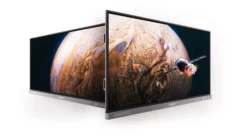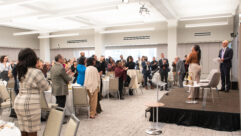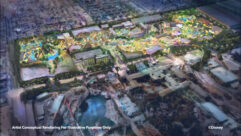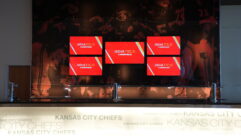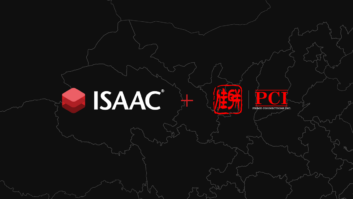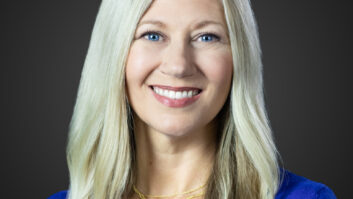
Pittsburgh, PA—September 2017…Cities of Asylum began with European cities providing temporary support for endangered writers in exile. Inspired by author Salman Rushdie, famously persecuted for writingThe Satanic Verses,Pittsburgh artist Diane Samuels and husband Henry Reese founded a City of Asylum chapter on Pittsburgh’s North Side that is fast becoming a local center for global literature and culture.

Samuels and Reese began hosting programs showcasing exiled writers and other creative artists in their home, on streets, and in eventually under a tent on vacant lots in their neighborhood. Eventually, through a combination of public and private funding, they took over part of the 21,000-square-foot former Masonic Temple on North Avenue and created Alphabet City.. Pittsburgh creative services firm Clear Story designed and installed an extensive audio, visual, and lighting network to support the multi-disciplinary programming at the new facility, basing the audio network on three Symetrix Radius-series DSPs.
The first floor of Alphabet City is divided into three sections, each with one or more audio zones. The sections are separated by curtains and can be combined into a larger space. One side houses a bookstore with bookshelves on tracks that hold an extensive selection of multilingual translations. Behind the bookstore is a small multipurpose room. The other side is the home of Casellula, an offshoot of Brian Keyser’s New York City cheese and wine bar of the same name. In the center is the main 75-seat performance space, which can also incorporate the other spaces enabling seating of up to 200. In the basement are the lower lounge and the conference room. The second and third floors offer eight upscale apartments.
“We needed to be able to route audio and video to any space on the main and basement floors,” relates Clear Story’s Managing Director Doug McDermott. “The client also wanted the ability to record in any room and to automate as much as possible while staying flexible. That’s quite a challenge.”
Two Radius 12×8 EX DSPs handle the I/O for all hardwired audio. Output cards accommodate expansion needs and additional outputs as the venue’s programming requirements continue to grow. All amp channels come out of the two Radius 12×8 EXs. The Radius EXs route all audio inputs and outputs to Dante flows and send the streams to a Radius AEC DSP.
The 12×8 Symetrix Radius AEC DSP with VoIP card option is the primary processor for the matrix; it handles the matrix mixers for the automated control, as well as loudspeaker processing and limiters. “We have a loudspeaker manager on the output of every amp or speaker channel, as well as limiting, to prevent the less technical users from overdriving the loudspeakers,” notes McDermott.

It’s a complex system that serves a variety of spaces. “On the main floor, we have mono audio zones in each space,” McDermott details. “The restaurant, main performance room, bookstore, and the room in the rear of the bookstore have 70 volt ceiling speakers. We have audio zones in the main restrooms, and a zone pumps audio to the hallway and bathrooms in the back. In the basement are five more audio zones. Another zone pumps audio downstairs to the restaurant kitchen.”
Control of the system is via a custom built web-based interface that the client can access via any web browser. Different users can be assigned various levels of access and control based on their needs and level of expertise.
The performance space is equipped with a PreSonus StudioLive RM-series digital mixer with Dante card, providing house technicians with a more console-oriented interface to handle the venue’s wide range of productions—everything from live jazz to spoken word to immigration ceremonies for new citizens. Four channels of Shure QLX-D wireless mics, a Shure VP88 room mic, and four Blackmagic Design HyperDeck Studio Pro video recorders also connect to a Radius EX. Three video screens are fed by Barco ClickShare wireless presentation systems, with their audio feeds outputting to the Radius network. Everything is converted to Dante as early as possible via the Radius DSPs. Connect a laptop in one space, and the video and audio can be routed to any other spaces.
A high-end rack-mounted computer serves as a hardwired media server for the performance space, and a Blackmagic Designs video switcher serves the main screen, with two channels of audio in and out. All audio is hardwired into the Symetrix Radius EX system.
“The Symetrix Radius DSPs are the keys,” insists McDermott. “Symetrix has really shown its stars for us. I like the Symetrix people, the products ship quickly, and I get great customer support. Especially important, my guys love to control Symetrix DSPs. The Radius’ ability to control everything within a third-party system is incredible. We can work in a very simple way to control dozens of functions, and Symetrix fully implements the Dante specification, which is critical.”
Clear Story also supplied mobile audio I/O for the Dante system. “The client wanted to be able to record in any room. The simplest way to do this was to supply two small stage boxes that could tie into the Dante network. At the time of specification, nobody made a small I/O so we came up with a creative solution using Attero Tech unD3IO units,” confirms McDermott. “We customized outdoor-rated plastic boxes to house unD3IO interfaces, which provide audio in and out for the network. A piece of ruggedized Ethernet cable comes out through a compression fitting and plugs into a network jack, and because of the way Dante works, it doesn’t matter which jack they connect to. The client can have as many interfaces as they want and move them where needed.”
McDermott points to future needs the system will fill as well. “As their program expands, they will have a need for multilingual translations during live events,” he observes. “Translators can be positioned in another room, and their feeds recorded and sent out to the audience. Using the UnDNEMO-BT, each translator can have a discrete audio I/O with volume control, and wear a Bluetooth headset.”
The Symetrix Radius-based system is working very well, and it continues to be developed. “Using Symetrix and Attero Tech, we felt very confident in the process,” McDermott concludes. “Symetrix delivered everything we needed. Without Radius DSPs, we would have struggled.”


